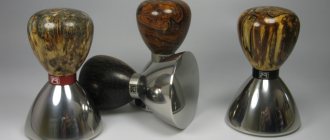Let's move a little away from opening a coffee shop and look at a common mistake baristas make in a small theoretical experiment, but first, a few boring facts.
To make espresso, ground coffee is tamped with a tamper in a holder, resulting in the formation of a coffee tablet.
Any barista knows that if the coffee tablet is tamped weakly, the coffee will not be saturated, all the most valuable substances will remain in the tablet. If you tamp too much, the result will be the opposite - the drink will be too bitter, since the water will take a long time to pass through the dense layer of coffee. But what happens if you press the coffee even harder?
If you apply significant physical effort, pressing on the distemper with both hands for a considerable time, you can get a substance so dense that water practically cannot pass through it. We won’t be able to get a drink, but it’s easy to break the coffee machine.
What is a coffee tamper and why is it needed?
Every professional barista or true fan of quality espresso in their home kitchen has a tamper. This is not a whim or a tribute to fashion. Temper has important functional significance.
The name of the accessory comes from the English term “tamping”, translated as “tamping”.
The tamper presses the coffee in the portafilter, compacting the coffee powder into a coffee tablet. Tamping is needed to slow down the rate of water flow through it, as well as to increase the uniformity of wetting of the coffee. An even flow of water through the entire coffee mass ensures optimal extraction, and, consequently, high quality of the finished drink. If the water flows too quickly or unevenly, the coffee will be weak, watery, and overly sour.
The professionalism of a barista means the consistent taste of every cup of espresso brewed. Good temping compacts each coffee tablet, allowing water to flow evenly at a low speed.
Tempering is so important to a barista that there are special workshops and classes that focus only on tamping techniques. There are also special educational materials: books, lectures, and video courses. And they all directly point out: the quality of the tamper determines the temperament. That is why this small accessory is a must-have tool for a good barista or a fan of real espresso.
How to use a tamper
Most espresso brewing manuals include tempering rules. Special courses for the barista profession help you learn in practice how to use a special device.
For you:
Coffee and tea in one glass: recipes
The main condition is that the dimensions of the press must fit the holders. The barista should use a digital scale to take out as much ground coffee as the recipe calls for. Professionals determine the coffee mass by eye and add it without additional measuring on a scale.
To avoid slipping, make a bookmark on a special mat. Coffee is poured into the holder, then the mass is distributed in the filter. The barista should tap the sides with his palms, then press the press firmly against the surface.
If everything is done correctly, you will get a dense and even tablet. The barista should refrain from rotating the tamper and unnecessary movements. If you scroll the tamper, bevels are formed. They cause uneven extraction.
Coffee tampers: shape, type, material of manufacture
For a long time, temperas were made from simple and cheap plastic, until the American Rage Barber, dissatisfied with the inconvenience of working with plastic models and the quality of the tamper, decided to take matters into his own hands. He began to produce heavy temperas with comfortable, ergonomic handles. Now his company is an industry leader, and branded tampers from Barber often become prizes at professional competitions.
The niche was quickly mastered by other manufacturers of coffee accessories, continuing and developing the idea of a convenient and weighty tamper. Today they are produced from different materials, with platforms of various sizes and shapes.
Tempera platform shape
It can be flat or convex, round. Baristas and experts still can't agree on which form is best.
- The flat platform allows you to create a uniform coffee tablet.
- Convex tampers compact the middle of the coffee, leaving the sides of the tablet slightly higher.
Each option has its fans. Entire monographs have been written about the advantages of one form or another of the platform. Setting aside the emotions surrounding this topic, flat platforms are suitable for double portafilters, while convex tampers give good results for single portafilters.
Flat tampers can have a smooth platform or a convex pattern in the form of concentric circles that leave marks on the ground coffee. Experts agree that there is no functional difference between a smooth or patterned platform; this does not affect the quality of temping.
Material of manufacture
- Plastic is the cheapest material; low-quality temperas are made from it.
- Aluminum is better than plastic, but is susceptible to corrosion in wet environments and is too light for a good seal.
- Steel is the best material for distemper soles, as it is heavy, durable, durable, and does not oxidize or rust.
- Wood - not platforms are made from it, but handles for the best dispensers.
Dimensions
There are two important dimensional parameters - the diameter and height of the distemper platform. For branded models of industrial production, the platform diameter is usually standard: 53, 57 or 58 mm, height – 7-10 mm. For hand-made tampers, these parameters are calculated during manufacture and depend on the size of the portafilter. The ideal diameter of the tamper should be 0.5-1 mm smaller than the diameter of the filter. If the holder is cone-shaped, then the diameter of the platform is calculated for the narrowest part.
Manufacturers and prices
Accessories are produced by many manufacturers of coffee equipment for baristas: Motta, Tiamo, Brewista. The cost of steel tampers with wooden handles ranges from 2100-2200 rubles. All-steel cast temperas are cheaper - from 1,500 rubles.
Unbranded accessories will cost from 1,100 rubles.
Branded temperas from Reg Barbera cost from 4.5-5 thousand rubles. But it is possible to assemble an accessory to order, choosing separately the handle and platform according to your taste and size.
What is tempera made from?
Inexpensive models are made of aluminum and plastic. Plastic presses do not perform their primary functions very well. Due to insufficient weight, the result during pressing will be insufficient. Tools made of plastic quickly fail and are short-lived. Sometimes it is easier to replace the tamper with a better one rather than purchasing another one made of plastic.
The aluminum work surface lasts longer. Its peculiarity is that the material is susceptible to small scratches.
The best raw materials for the working part of the distemper:
- brass;
- stainless steel;
- copper.
Parts are made on lathes. Wizards set certain forms and parameters. Hand grinding is the most reliable. Suitable diameters for coffee makers: 51 mm, 52 mm, 53 mm, 55 mm, 57 mm and 58 mm. The last two are used for professional coffee machines.
The handles are made of wood and aluminum. Expensive models made from valuable wood species are in particular demand. The walnut or maple handles last a long time and are also very comfortable. Mandatory processing of the handles: craftsmen give them an ergonomic shape, then grind and impregnate them with oil. The last final stage is varnishing.
Aluminum elements are coated with special powder paint. Craftsmen use anodizing techniques to prevent the metal surface from oxidizing.
How to choose a tamper?
Models with a steel platform and a wooden handle are considered comfortable and functional. They are reliable and last a long time. You can buy a ready-made accessory or make it to order according to drawings.
In order to choose a good tamper, you need to know some of the features of the coffee maker you will be working with.
- Portafilter diameter. The tamper you purchase should be only slightly smaller in diameter than the narrowest part of the filter. If the tamper is too small, it will be difficult to tamp the coffee.
- Double or single filter in a coffee maker. For a double holder, experts advise buying a flat tamper; for a single holder, you can choose the shape of the platform to your liking. If you are just starting to work with coffee, it is better to take a flat tamper; it will allow you to quickly achieve uniform tamping. However, only the barista himself can give a definite answer on the preferred form of the tamper while working.
The final stage of coffee tamping
The camera, along with the coffee shop and the barista, will instantly (relative to themselves) be pulled beyond the event horizon and disintegrated into atoms. The black hole will begin to rotate around the center of the Earth, constantly sucking in matter and gradually moving towards the center. Human civilization and all life on the planet will be destroyed.
After some time, instead of the planet, a black hole will remain, which will continue to grow slowly due to the fall of asteroids and comets into it. Eventually, after a very long period of time, the neighboring planets and the Sun will be absorbed, and the coffee black hole will become the new center of the system, unless the heat death of the universe occurs first.
Coffee tamper: our conclusion
- Needed for uniform compaction of dry coffee in a holder (portafilter).
- It can have a flat or convex platform; which is better is up to the barista to decide.
- The best tampers have a stainless steel platform and a wooden handle.
- The diameter of the tempera platform should be 0.5-1 mm smaller than the diameter of the coffee machine filter.
- They are produced by different manufacturers, but products from Reg Barbera are considered luxury.
- Cost – from 2000 rubles.
- Can be made to order.
Tamping coffee in a special chamber
And we will have to abandon industrial technology and make a special chamber for further compression.
The grain of sand must levitate in the center of the chamber and balanced forces must be uniformly applied to it. Compression occurs as these forces increase. The main problem of this method is the need for a colossal and unattainable amount of energy, but this is a different question.
At a certain point, when the radius of our sample decreases to the Schwarzschild radius for a given mass, further compression will not be needed, since the gravitational forces among the coffee atoms will reach such values that the atoms will continue to shrink on their own and our sample will collapse into a black hole. This is real black coffee.
How to properly temper coffee
The process of laying ground grains must be taken responsibly. To perform these steps correctly, you must adhere to the following instructions:
- Before you start tamping, you need to even out the coffee powder. There should be no pits or bumps on the surface.
- Place the tamper on top of the coffee and press down. It is extremely important to ensure that its placement is level.
- During the first application, you need to ensure that the level of smoothing is ideal.
- The next time you apply it, the force is already applied. The optimal pressure is considered to be 15 kg.
A tamper is an easy-to-use accessory, thanks to which you can prepare espresso at home, which is not inferior in taste to that prepared in coffee shops. The main thing is to choose it correctly and strictly follow the rules for tamping coffee powder. At the same time, you will have the opportunity to pamper yourself and your loved ones every day with an amazingly delicious coffee drink.
Varieties
Temperas are distinguished according to the following characteristics:
- Shape – can be flat, convex.
- Dimensions.
- In appearance, the platform is smooth, with notches.
- Material of manufacture: steel, aluminum.
- Depending on the material of the handle – wood, plastic or other materials.
Each barista prefers to work with a certain form of equipment. It is believed that a straight heel is more suitable for a double horn, a convex heel for a single horn.
The handle is ergonomically shaped so that it is comfortable to place your palm on it and control the pressure with your fingers. The tamper can be with or without a handle. The second option has a limiter, but it is not very convenient to use. The most popular is the coffee tamper with a massive smooth handle.
Corrugations or nicks on the bottom of the tamper do not affect the quality of the seal, but water penetrates better into the grooves, although this fact is debatable, and the poor quality of the coffee maker cannot be improved by expensive tablet seals.
The size of a coffee tamper is usually selected according to the available horn. The diameter of the holder should be slightly larger than the tempera so that it fits easily. Its height should also not exceed the height of the horn, so that the coffee tablet is below the edge of the holder. Otherwise, the water will overflow.











